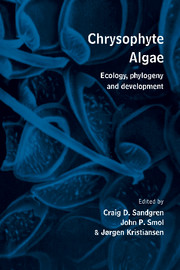Book contents
- Frontmatter
- Contents
- Preface
- List of contributors
- 1 History of chrysophyte research: origin and development of concepts and ideas
- Part I Phylogeny, systematics and evolution
- Part II Development, physiology and nutrition
- 5 Comparative aspects of chrysophyte nutrition with emphasis on carbon, phosphorus and nitrogen
- 6 Mixotrophy in chrysophytes
- 7 Biomineralization and scale production in the Chrysophyta
- 8 Immunological and ultrastructural studies of scale development and deployment in Mallomonas and Apedinella
- Part III Ecology, paleoecology and reproduction
- Part IV Contributed original papers
- Index of scientific names
- Subject index
5 - Comparative aspects of chrysophyte nutrition with emphasis on carbon, phosphorus and nitrogen
Published online by Cambridge University Press: 05 March 2012
- Frontmatter
- Contents
- Preface
- List of contributors
- 1 History of chrysophyte research: origin and development of concepts and ideas
- Part I Phylogeny, systematics and evolution
- Part II Development, physiology and nutrition
- 5 Comparative aspects of chrysophyte nutrition with emphasis on carbon, phosphorus and nitrogen
- 6 Mixotrophy in chrysophytes
- 7 Biomineralization and scale production in the Chrysophyta
- 8 Immunological and ultrastructural studies of scale development and deployment in Mallomonas and Apedinella
- Part III Ecology, paleoecology and reproduction
- Part IV Contributed original papers
- Index of scientific names
- Subject index
Summary
Introduction
Consideration of the nutrition of chrysophytes from a biochemical or biophysical viewpoint in comparison with that of other algal taxa has become relatively more difficult over the years. This is not necessarily a function of laxness in using presumptive chrysophytes for such work, but rather that many of the more widely used genera are now classified in other major taxa. The most obvious examples are the separation of the class Prymnesiophyceae, with such nutritionally well investigated genera as Emiliania, Isochrysis and Pavlova, and the recognition that Olisthodiscus (Heterosigma), a molecular-genetically and cell-biologically well understood organism, is probably a chloromonad (raphidophyte) (Heywood 1989; Patterson & van Valkenberg 1990). Even fewer data would be available if the chrysophytes sensu stricto were considered in the absence of the recently separated Synurophyceae. However, both of these classes (Chrysophyceae and Synurophyceae) are considered here, as are recently discovered marine picoplanktonic chrysophytes (Anderson 1987; Shapiro et al. 1989; Keller & Rice 1989), giving a range of organisms from marine picoplankton, through the more familiar freshwater unicells and colonies, to the large benthic freshwater Hydrurus.
To be more positive, there is a substantial body of data on various aspects of nutrition in the chrysophytes. We start by considering the evidence as to the ratio of major nutrients found in chrysophytes growing at their maximum specific growth rates, their qualitative allocation to different molecular species, and the mechanism of synthesis of these molecular species from such common intracellular substrates as hexose, ammonium and phosphate.
- Type
- Chapter
- Information
- Chrysophyte AlgaeEcology, Phylogeny and Development, pp. 95 - 118Publisher: Cambridge University PressPrint publication year: 1995
- 17
- Cited by

